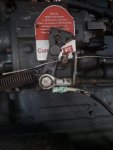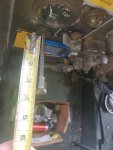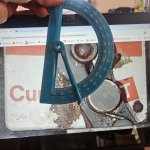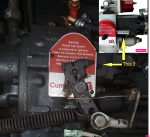The interior of the little screen is the intake side , which is unusual but that's how those are..
if I understand these engines correctly, it's the injectors themselves that open to release the high pressure fuel and create return flow, not the PT pump... The PT only draws from the tank and creates the volume (and about 200psi?) to give a constant feed to the injectors simultaneously.
If I understand Will Wagner correctly, if the PT isn't pumping to the heads, nor the injectors moving, the injectors aren't releasing any unused fuel .. The injectors on these engines are like mini injection pumps, all by themselves.. A push rod off the cam actuates the injector rocker, which then pushes on the injector to cause the squirt .. I myself have tried to make sense of this system thinking it was like a "normal" fuel rail system , but it isn't ..
That's also a big reason why the engine will eventually speed up to a scream all by itself when the throttle lever is pulled part way for a fast idle. The speed just keeps multiplying with each faster and faster injection cycle, a domino effect. I have yet to understand why it happens with the throttle, because it doesn't seem to happen if you hold the accelerator pedal at a fast idle .. doesn't make sense
Sorta. The system, PT, Pressure Timed. The pump makes flow only below a specified RPM, and boost when turbo charged. The injectors take the fuel in, trap a specified amount when the plunger is forced down out of the metering position and then passed down through a check ball equipped passage in the barrel. The barrel and plunger are class fit pieces, meant to have a small amount of leakage between the two components for cooling and lubrication. It is a long, drawn out process on how the fuel gets metered as the RPM increases the amount of fuel also increases even though the passages are the same but the rail pressure increases. It is all pressure timed, hence PT fuel system. It took a bit to learn it and it is slowly fading away, well, quickly since the system wasn't used after 1992 and since I was mostly automotive, on road, this system faded into darkness. I do miss it.
When the system is interrupted, opened, whatever, that is the reason that these are hard starting, smoke white, RPM hangs up, etc, until the engine has been worked enough to push out all the little air bubbles in the system. The high pressure is made by the physical downward force created by the cam lobe that forces the injector plunger down into the cup and atomized into the cylinder.
Flow from the injector return cn happen if pressurized, but one or more injector plungers need to be just right in order for the dump cavity to be aligned for return. About 40%? of the fuel pumped to the injectors gets returned. Yes, that ? was intended, I do not remember the exact amount.
Somewhere in this thread, I read that the return at the pump was looked at and no PSI? Shouldn't be any pressure there, only flow, return flow. The PT pump return ties into the injector return. There is a check valve at the fuel pump gear pump, that 90 degree #4 fitting on top of the inlet section of the pump. The gear pump shunts some of the fuel sucked in for cooling, lubrication and, in off throttle situation, like a sudden decel, the fuel gets pushed out that line to prevent the gear pump drive from snapping when fuel demand is suddenly decreased, remember, the throttle shaft closes the holes off and the fuel need someplace to go when it is under pressure. This is also where the throttle shaft leakage comes into play. No fuel from the throttle shaft under decel, no lube to the injectors, stuck plunger and a miss.
It is kinda complicated until you learn and work with it. I did my apprenticeship at Cummins. It took a few years to learn it, understand what affected it and in what ways. It is a catch 22 kind of system, turboed anyway. Can't give fuel until you get manifold pressure, can't get manifold pressure until you get fuel. NA engines are a smidge different, only RPM based.











